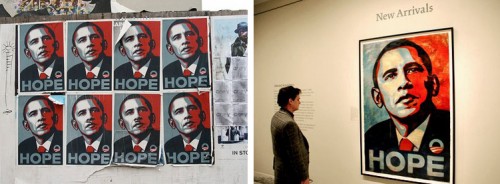 The New York Times recently published a piece titled “At Times, Obama and His Cyberself Differ on Tactics” that opens with the passage:
The New York Times recently published a piece titled “At Times, Obama and His Cyberself Differ on Tactics” that opens with the passage:
For a moment on Friday, the cyber-Barack Obama was perfectly at odds with the flesh-and-blood version… Speaking to 1,400 supporters at a high school… President Obama voiced his familiar lament that “there is so much negativity and so much cynicism” in politics that he could understand if voters tuned out the election. Minutes earlier on Twitter, he had written, “Why Mitt Romney’s end date at his buyout firm matters,” linking to a blog post about the tempest over his Republican challenger’s departure from Bain Capital.
The article doesn’t really offer any deeper analysis of the topic raised in its headline, but the notion of this sort of technologically-mediated, or even, post-human, presidency is so provocative that it’s worth additional reflection. I can’t begin such a reflection, however, without first critiquing some of the vocabulary used in the article. The article contrasts “cyber-Barack Obama” (or Barack Obama’s “cyberself”) with “the flesh-and-blood version.” This problematically implies that there are two Barack Obamas: the real Obama and the Obama out there in cyberspace (cue creepy space music). Of course, once we even state such a claim, it becomes immediately apparent that it has zero face validity. Arguing that the Barack Obama who signs the messages he personally posts to Twitter with the initials “bo” is different than the Barack Obama out there giving the speeches makes about as much sense as arguing that when I call my mom on telephone, I’m talking to a different person than when I drive over for a visit.
In fact, this whole digital dualist discussion of cyber-Obama actually obscures the much bigger distinction that this example highlights: Obama the person versus Obama the brand. Contrary to what this article suggests, the distinction between the person of the president and the presidential brand is not a novelty of the Internet (though it may be manifesting in new ways). Since our nation’s founding, the presidency has embodied more than just the convictions and creative capacities of a single individual. Surely, even Washington endorsed words and images that were not wholly of his design. Certainly by the time Washington made his 1796 farewell address (in which he famously warned against the negative influence of political parties on democracy), the prospect of a party-administered campaign was already on the horizon. The contemporary party apparatus has grown so enormous that it is impossible for a candidate to even meet all his/her surrogates (e.g., all the staffers and interns who customize region mailings, the phone bank operators, the door-to-door solicitors, etc.)

Political parties are significant in that they extend and amplify the message of the candidate. In the case of a presidential system (where individual persons are on the ballot, and not the parties themselves [as with parliamentary systems]), the president is supposed to represent, and even embody, the goals and aspirations of the party. In this way, collective interests are manifest in an individual. However, the merging of the collective and the individual is not unidirectional. The goals of the party are not merely manifest in the president, but the president also cedes a degree of autonomy, allowing the party to speak on his (or, hopefully, one day soon, her) behalf. In short, the image of the president is mediated through the party apparatus.
Mediation—through the party, which acts both as organizational technology and medium of communication—transforms the president from an individual office-seeker into a brand. The purpose of branding is to turn the president’s performance of self into something that can be mass-marketed. But, as the layers of mediation increase, the individual official is subsumed into the brand. That is to say that the president cedes control over his individual identity to the collective.
The presidential brand is an example of what Guy Debord called “spectacle,” where what “was once directly lived has moved into a representation.” Representations of the president are far easier to circulate as a sort of cultural commodity than the president’s own personal performances of self. In order to “sell” the president, a campaign (and its supporters) must first create images of him that are highly fluid—even viral (consider the circulation of Shepard Fairy’s iconic “hope” imagery, which was acquired by the National Portrait Gallery).
Obama’s mediation through these new technologies does not somehow create a cyber-Obama distinct from the “real” Obama. There is only one Obama—one mediated by a whole host of technologies. Again, the existence of this sort of mediated presidency is not new. Before Obama was born, Roosevelt was defined through the performance of his fireside chats on radio, while televised debates made Kennedy. Both were carefully scripted representations.
This anecdote about the @BarackObama Twitter account (“run by #Obama2012 campaign staff… Tweets from the president signed -bo”) saying things that seem to contrast what Obama is saying simultaneously in his speeches is interesting, not because it demonstrates the existence of a virtual president, but because it highlights just how heavily-mediated our image of the president is. It makes us aware that the president we know is more a brand than a person. Moreover, the jarring aspect of the anecdote is not that it calls into question whether the Obama who communicates with using the Internet is less real than the Obama who uses analog communication (e.g., pamphlets, print ads, phone messages, etc.) but that it challenges the authenticity of the Obama brand, which appears contrived when inconsistencies emerge—precisely why “flip-flopper” has become the most powerful invective in contemporary politics.


Comments 2
Politics, Identity, Branding » The Editors' Desk — July 19, 2012
[...] Over the past months, we’ve been trying to encourage our authors and contributors to turn their attention and expertise to politics, a top-of-mind topic for so many readers. A few days ago, Cyborgology author PJ Rey did just that, with a provocative post in our Community Pages on the marketing and public personae of Barack Obama: “The President as Brand.” [...]
What I Read This Week – 22nd July - A Literal Girl — July 23, 2012
[...] The President as a Brand (PJ Rey at Cyborgology) Obama’s mediation through these new technologies does not somehow create [...]